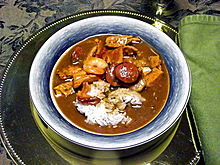Portal:Food
F o o d
A portal dedicated to food and foodways
Introduction


Food is any substance consumed by an organism for nutritional support. Food is usually of plant, animal, or fungal origin and contains essential nutrients such as carbohydrates, fats, proteins, vitamins, or minerals. The substance is ingested by an organism and assimilated by the organism's cells to provide energy, maintain life, or stimulate growth. Different species of animals have different feeding behaviours that satisfy the needs of their metabolisms and have evolved to fill a specific ecological niche within specific geographical contexts.
Omnivorous humans are highly adaptable and have adapted to obtain food in many different ecosystems. Humans generally use cooking to prepare food for consumption. The majority of the food energy required is supplied by the industrial food industry, which produces food through intensive agriculture and distributes it through complex food processing and food distribution systems. This system of conventional agriculture relies heavily on fossil fuels, which means that the food and agricultural systems are one of the major contributors to climate change, accounting for as much as 37% of total greenhouse gas emissions. (Full article...)
Cooking, also known as cookery or professionally as the culinary arts, is the art, science and craft of using heat to make food more palatable, digestible, nutritious, or safe. Cooking techniques and ingredients vary widely, from grilling food over an open fire, to using electric stoves, to baking in various types of ovens, reflecting local conditions. Cooking is an aspect of all human societies and a cultural universal.
Preparing food with heat or fire is an activity unique to humans. Archeological evidence of cooking fires from at least 300,000 years ago exists, but some estimate that humans started cooking up to 2 million years ago.
The expansion of agriculture, commerce, trade, and transportation between civilizations in different regions offered cooks many new ingredients. New inventions and technologies, such as the invention of pottery for holding and boiling of water, expanded cooking techniques. Some modern cooks apply advanced scientific techniques to food preparation to further enhance the flavor of the dish served. (Full article...)
Miran Pastourma is a renowned pastourma and sujuk charcuterie business and market in Athens, Greece. The market has been in operation since 1922. It is considered the charcuterie of the connoisseurs. Despite the Greek economic crisis, Miran is expanding its business and has doubled in size to accommodate increased demand. The founder of the shop, Miran Kourounlian, is thought to be the man who brought pastourma to Athens for the first time. Miran is considered the largest company of its kind in the European Union. The flavour of pastourma coming from the historical enterprise permeates Euripides Street in the centre of Athens. Miran and its neighbor Arapian Cold Cuts are considered two of the historical establishments of Athens. Miran has been in the same spot in Euripidou Street since its opening in 1922. Miran is the recipient of multiple gourmet prizes. (Full article...)
Selected article –
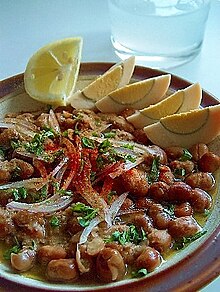
Selected cuisine -
Jewish cuisine refers to the worldwide cooking traditions of the Jewish people. During its evolution over the course of many centuries, it has been shaped by Jewish dietary laws (kashrut), Jewish festivals and holidays, and traditions centred around Shabbat. Jewish cuisine is influenced by the economics, agriculture, and culinary traditions of the many countries where Jewish communities have settled and varies widely throughout the entire world.
The history of Jewish cuisine begins with the cuisine of the ancient Israelites. As the Jewish diaspora grew, different styles of Jewish cooking developed. The distinctive styles in Jewish cuisine vary according to each community across the Ashkenazi, Sephardi, and Mizrahi diaspora groupings; there are also notable dishes within the culinary traditions of the standalone significant Jewish diaspora communities from Greece, Iran, and Yemen. (Full article...)Selected ingredient –
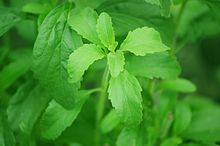
Stevia (/ˈstiːviə, ˈstɛviə/) is a sweet sugar substitute that is about 50 to 300 times sweeter than sugar. It is extracted from the leaves of Stevia rebaudiana, a plant native to areas of Paraguay and Brazil in the southern Amazon rainforest.[dubious – discuss] The active compounds in stevia are steviol glycosides (mainly stevioside and rebaudioside). Stevia is heat-stable, pH-stable, and not fermentable. Humans cannot metabolize the glycosides in stevia, and therefore it has zero calories. Its taste has a slower onset and longer duration than that of sugar, and at high concentrations some of its extracts may have an aftertaste described as licorice-like or bitter. Stevia is used in sugar- and calorie-reduced food and beverage products as an alternative for variants with sugar.
The legal status of stevia as a food additive or dietary supplement varies from country to country. In the United States, certain high-purity stevia glycoside extracts have been generally recognized as safe (GRAS) and may be lawfully marketed and added to food products, but stevia leaf and crude extracts do not have GRAS or Food and Drug Administration (FDA) approval for use in food. The European Union approved Stevia rebaudiana additives in 2011. In Japan, stevia has been widely used as a sweetener for decades. (Full article...)
Selected recipe –
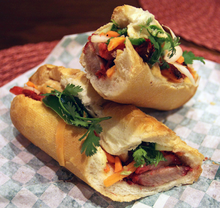
In Vietnamese cuisine, bánh mì or banh mi (/ˈbɑːn miː/, /ˈbæn/; Vietnamese: [ɓǎjŋ̟ mì], 'bread') is a short baguette with thin, crisp crust and a soft, airy texture. It is often split lengthwise and filled with meat and savory ingredients like a submarine sandwich and served as a meal, called bánh mì thịt. Plain bánh mì is also eaten as a staple food.
A typical Vietnamese roll or sandwich is a fusion of meats and vegetables from native Vietnamese cuisine such as chả lụa (Vietnamese sausage), coriander (cilantro), cucumber, pickled carrots, and pickled daikon combined with condiments from French cuisine such as pâté, along with red chili and mayonnaise. However, a variety of popular fillings are used, like xá xíu (Chinese barbecued pork), xíu mại Vietnamese minced pork, and nem nướng grilled pork sausage, to even ice cream which are more of a dessert. In Vietnam, bread rolls and sandwiches are typically eaten for breakfast, or as a snack. (Full article...)
Gumbo (Louisiana Creole: Gum-bo) is a stew that is popular in the U.S. state of Louisiana and is the official state cuisine. Gumbo consists primarily of a strongly flavored stock, meat or shellfish (or sometimes both), a thickener, and the Creole "holy trinity" – celery, bell peppers, and onions. Gumbo is often categorized by the type of thickener used, whether okra or filé powder (dried and ground sassafras leaves).
Gumbo can be made with or without okra or filé powder. The preferred method in the historical New Orleans variation is with a French dark, even chocolate-like, roux. The flavor of the dish has its origins in many cultures. Creole gumbo generally contains shellfish and a dark roux, filé, or both. Cajun gumbo is generally based on a dark roux and is made with shellfish or fowl. Sausage or ham is often added to gumbos of either variety. After the base is prepared, vegetables are cooked down, and then meat is added. The dish simmers for a minimum of three hours, with shellfish and some spices added near the end. If desired, filé powder is added after the pot is removed from heat. Gumbo is traditionally served with rice. A third, lesser-known variety, the meatless gumbo z'herbes, is essentially a gumbo of slow-cooked greens. (Full article...)Selected image –
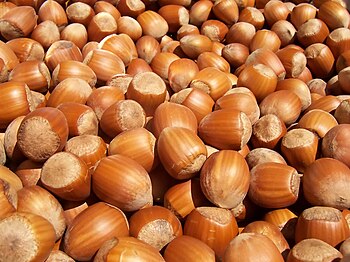
Selected biography –
B. November 8, 1966
Gordon James Ramsay OBE (/ˈræmzi/; born 8 November 1966) is a British celebrity chef, restaurateur, television presenter, and writer. His restaurant group, Gordon Ramsay Restaurants, was founded in 1997 and has been awarded 17 Michelin stars overall and currently holds eight. His signature restaurant, Restaurant Gordon Ramsay in Chelsea, London, has held three Michelin stars since 2001. After rising to fame on the British television miniseries Boiling Point in 1999, Ramsay became one of the best-known and most influential chefs in the world.
Ramsay's TV persona is defined by his fiery temper, aggressive behaviour, strict demeanour, and frequent use of profanity, while making blunt, critical, and controversial comments, including insults and sardonic wisecracks about contestants and their cooking abilities. He combines activities in the television, film, hospitality and food industries, and has promoted and hired various chefs who have apprenticed under his wing. He is known for presenting television programmes about competitive cookery and food, such as the British series Hell's Kitchen (2004), Ramsay's Kitchen Nightmares (2004–2009, 2014), and The F Word (2005–2010), with Kitchen Nightmares winning the 2005 British Academy Television Award for Best Feature, and the American versions of Hell's Kitchen (2005–present), Kitchen Nightmares (2007–present), MasterChef (2010–present), and MasterChef Junior (2013–present), as well as Hotel Hell (2012–2016), Gordon Behind Bars (2012), Gordon Ramsay's 24 Hours to Hell and Back (2018–2020), and Next Level Chef (2022–present). (Full article...)
Did you know (auto-generated) –

- ... that within the Armenian Rite, it takes 40 days and more than 40 flowers, herbs, and spices to create the chrism known as myron?
- ... that environmental activist Nigel Savage created Hazon after googling "Jewish food movement" and receiving zero search results?
- ... that Turkish migrant workers living in a residential complex in Amsterdam refused to eat the Dutch food for two weeks after the kitchen's only Turkish chef was fired?
- ... that when Mexia Supermarket was abandoned because of its owners' bankruptcy, all of the food inside was left to rot for more than three months?
- ... that Gleaners Food Bank has served more than 700 million pounds (320 million kg) of food in Indiana?
- ... that food psychology research has found that the COVID-19 pandemic led to both reduced and increased consumption of junk food among different geographical populations and educational backgrounds?
More did you know –
Related portals
Food topics
The following are topics relating to food
Categories
Food list articles
- See also: Lists of foods and Category:Lists of drinks
The following are some Food list articles on Wikipedia:

- American cheeses
- Appellation d'Origine Contrôlée cheeses
- Apple cultivars
- Bacon dishes
- Bacon substitutes
- Basil cultivars
- Breads
- Breakfast beverages
- Breakfast cereals
- Breakfast foods
- British cheeses
- Cakes
- Candies
- Cheeses
- Cheese soups
- Christmas dishes (list)
- Cocktails
- Cookies
- Dishes using coconut milk
- Diets
- Doughnut varieties
- Egg dishes
- Fermented soy products
- Food additives
- Food additives (Codex Alimentarius)
- Foods named after people
- French cheeses
- French dishes
- Fried dough foods
- Fruits
- List of hamburgers
- Herbs and spices
- Hors d'oeuvre
- Indian dishes
- Indian snack foods
- Indonesian dishes
- Italian dishes
- Japanese snacks
- Japanese dishes
- Jewish dishes
- Kebabs
- Korean beverages
- Mango cultivars
- Moroccan dishes
- Pasta
- Pastries
- Philippine snack food
- Pies, tarts and flans
- Poppy seed pastries and dishes
- Potato dishes
- Puddings
- Raw fish dishes
- Rice dishes
- Rolled foods
- Sauces
- Seafood
- Seeds
- Sandwiches
- Snack foods
- Soft drinks by country
- Soul foods and dishes
- Soups
- Stews
- Street foods
- Tapas
- Turkish dishes
- Twice-baked foods
- Vegetable oils
- Vegetables
- Vodkas
Things you can do
Related WikiProjects
| Parent project: WikiProject Food and Drink | |
| Child projects: | Task forces: (All inactive) |
|
|
| Related projects: | |
New articles
Rules | Match log | Results page (for watching) | Last updated: 2024-08-25 19:23 (UTC)
Note: The list display can now be customized by each user. See List display personalization for details.
- Halen Môn (edit | talk | history | links | watch | logs | tools) by Jonathan Deamer (talk · contribs · new pages (2)) started on 2024-08-25, score: 20
- Ecclefechan tart (edit | talk | history | links | watch | logs | tools) by Nealsie (talk · contribs · new pages (1)) started on 2024-08-25, score: 20
- Agriculture (Ants) (edit | talk | history | links | watch | logs | tools) by AgisdeSparte (talk · contribs · new pages (3)) started on 2024-08-25, score: 10
- Cyclocybe erebia (edit | talk | history | links | watch | logs | tools) by Shroomysean (talk · contribs · new pages (2)) started on 2024-08-25, score: 10
- Masak lemak lada api (edit | talk | history | links | watch | logs | tools) by AyyanD (talk · contribs · new pages (5)) started on 2024-08-25, score: 10
- Benne wafer (edit | talk | history | links | watch | logs | tools) by NotactuallyaDJ (talk · contribs · new pages (1)) started on 2024-08-24, score: 20
- Koia (edit | talk | history | links | watch | logs | tools) by Lena Key (talk · contribs · new pages (1)) started on 2024-08-24, score: 20
- Johann Baptist Fuchs (edit | talk | history | links | watch | logs | tools) by Historybuff0105 (talk · contribs · new pages (6)) started on 2024-08-24, score: 10
- Geomryeongso (edit | talk | history | links | watch | logs | tools) by TeddyRoosevelt1912 (talk · contribs · new pages (3)) started on 2024-08-23, score: 10
- Torcetti (edit | talk | history | links | watch | logs | tools) by AKeen (talk · contribs · new pages (2)) started on 2024-08-23, score: 30
- Sunny Jim (peanut butter) (edit | talk | history | links | watch | logs | tools) by Purplebackpack89 (talk · contribs · new pages (16)) started on 2024-08-23, score: 10
- Câche Câche (restaurant) (edit | talk | history | links | watch | logs | tools) by Another Believer (talk · contribs · new pages (130)) started on 2024-08-23, score: 10
- Association for Plant Breeding for the Benefit of Society (edit | talk | history | links | watch | logs | tools) by Teluobir (talk · contribs · new pages (2)) started on 2024-08-23, score: 10
- Brijesh Tiwari (edit | talk | history | links | watch | logs | tools) by Schwede66 (talk · contribs · new pages (6)) started on 2024-08-23, score: 10
- Rasika (restaurant) (edit | talk | history | links | watch | logs | tools) by Another Believer (talk · contribs · new pages (130)) started on 2024-08-23, score: 10
- Mountain Dew LiveWire (edit | talk | history | links | watch | logs | tools) by MC-123 (talk · contribs · new pages (11)) started on 2024-08-22, score: 20
- Pizza in North Korea (edit | talk | history | links | watch | logs | tools) by Vigilantcosmicpenguin (talk · contribs · new pages (14)) started on 2024-08-22, score: 20
- List of Michelin-starred restaurants in Vietnam (edit | talk | history | links | watch | logs | tools) by Another Believer (talk · contribs · new pages (130)) started on 2024-08-22, score: 20
- List of Michelin-starred restaurants in Ireland (edit | talk | history | links | watch | logs | tools) by Another Believer (talk · contribs · new pages (130)) started on 2024-08-22, score: 20
- Portrait of Toulouse Lautrec, in Villeneuve-sur-Yonne, with the Natansons (edit | talk | history | links | watch | logs | tools) by Viriditas (talk · contribs · new pages (16)) started on 2024-08-22, score: 20
- Pizza bianca (edit | talk | history | links | watch | logs | tools) by Un assiolo (talk · contribs · new pages (3)) started on 2024-08-21, score: 10
- Tavern-style pizza (edit | talk | history | links | watch | logs | tools) by The ed17 (talk · contribs · new pages (14)) started on 2024-08-21, score: 30
- Mapo Ok (edit | talk | history | links | watch | logs | tools) by Seefooddiet (talk · contribs · new pages (105)) started on 2024-08-17, score: 10
- Goosefoot (restaurant) (edit | talk | history | links | watch | logs | tools) by Tbhotch (talk · contribs · new pages (94)) started on 2024-08-20, score: 10
- Samyang Dabang (edit | talk | history | links | watch | logs | tools) by Seefooddiet (talk · contribs · new pages (105)) started on 2024-08-19, score: 20
- Pixtle (edit | talk | history | links | watch | logs | tools) by Spencercostanzo (talk · contribs · new pages (1)) started on 2024-08-19, score: 10
- Love Shack (bar) (edit | talk | history | links | watch | logs | tools) by Another Believer (talk · contribs · new pages (130)) started on 2024-08-19, score: 10
- Badasoop (edit | talk | history | links | watch | logs | tools) by Seefooddiet (talk · contribs · new pages (105)) started on 2024-08-19, score: 20
- Paik's Coffee (edit | talk | history | links | watch | logs | tools) by Gray eyes (talk · contribs · new pages (46)) started on 2024-08-18, score: 20
- Compose Coffee (edit | talk | history | links | watch | logs | tools) by Gray eyes (talk · contribs · new pages (46)) started on 2024-08-18, score: 20
- Rasel (catering) (edit | talk | history | links | watch | logs | tools) by Monophile (talk · contribs · new pages (1)) started on 2024-08-17, score: 10
- Vij's (restaurant) (edit | talk | history | links | watch | logs | tools) by Another Believer (talk · contribs · new pages (130)) started on 2024-08-16, score: 10
- Phnom Penh (restaurant) (edit | talk | history | links | watch | logs | tools) by Another Believer (talk · contribs · new pages (130)) started on 2024-08-16, score: 10
- Lunch Lady (restaurant) (edit | talk | history | links | watch | logs | tools) by Another Believer (talk · contribs · new pages (130)) started on 2024-08-16, score: 10
- Anh and Chi (edit | talk | history | links | watch | logs | tools) by Another Believer (talk · contribs · new pages (130)) started on 2024-08-16, score: 10
- Fiorino (restaurant) (edit | talk | history | links | watch | logs | tools) by Another Believer (talk · contribs · new pages (130)) started on 2024-08-16, score: 10
- Fable Kitchen (edit | talk | history | links | watch | logs | tools) by Another Believer (talk · contribs · new pages (130)) started on 2024-08-16, score: 10
- Nightshade (restaurant) (edit | talk | history | links | watch | logs | tools) by Another Believer (talk · contribs · new pages (130)) started on 2024-08-15, score: 10
- Chupito (edit | talk | history | links | watch | logs | tools) by Another Believer (talk · contribs · new pages (130)) started on 2024-08-15, score: 10
- 2024 Mogadishu tea shop bombing (edit | talk | history | links | watch | logs | tools) by QalasQalas (talk · contribs · new pages (13)) started on 2024-08-17, score: 10
- Aaron J. Ihde (edit | talk | history | links | watch | logs | tools) by Suslindisambiguator (talk · contribs · new pages (8)) started on 2024-08-17, score: 10
- At Grenelle, Absinthe Drinker (edit | talk | history | links | watch | logs | tools) by Hoary (talk · contribs · new pages (6)) started on 2024-08-17, score: 20
- Terang bulan (edit | talk | history | links | watch | logs | tools) by Ledgeknew (talk · contribs · new pages (4)) started on 2024-08-17, score: 30
- Agege bread (edit | talk | history | links | watch | logs | tools) by AKeen (talk · contribs · new pages (2)) started on 2024-08-17, score: 30
- Smash burger (edit | talk | history | links | watch | logs | tools) by Another Believer (talk · contribs · new pages (130)) started on 2024-08-16, score: 30
- Antje Töpfer (edit | talk | history | links | watch | logs | tools) by Moondragon21 (talk · contribs · new pages (104)) started on 2024-08-16, score: 10
- List of independent English Whisky bottlers (edit | talk | history | links | watch | logs | tools) by ChefBear01 (talk · contribs · new pages (4)) started on 2024-08-16, score: 20
- Brian Niccol (edit | talk | history | links | watch | logs | tools) by AltruisticHomoSapien (talk · contribs · new pages (5)) started on 2024-08-13, score: 10
- Coniglio alla sanremese (edit | talk | history | links | watch | logs | tools) by IvanScrooge98 (talk · contribs · new pages (27)) started on 2024-08-16, score: 10
- The Sloth Lane (edit | talk | history | links | watch | logs | tools) by Prince Silversaddle (talk · contribs · new pages (3)) started on 2024-08-16, score: 20
- Boardner's (edit | talk | history | links | watch | logs | tools) by Gb321 (talk · contribs · new pages (9)) started on 2024-08-15, score: 10
- Vollpension (edit | talk | history | links | watch | logs | tools) by Surtsicna (talk · contribs · new pages (24)) started on 2024-08-15, score: 10
- Patrick Kelly (footballer, born 2004) (edit | talk | history | links | watch | logs | tools) by GiantSnowman (talk · contribs · new pages (27)) started on 2024-08-15, score: 10
- Habesha Breweries S.C (edit | talk | history | links | watch | logs | tools) by AsteriodX (talk · contribs · new pages (10)) started on 2024-08-15, score: 30
- President's House (Columbia University) (edit | talk | history | links | watch | logs | tools) by Normsupon (talk · contribs · new pages (1)) started on 2024-08-15, score: 10
- Hop water (edit | talk | history | links | watch | logs | tools) by Gråbergs Gråa Sång (talk · contribs · new pages (5)) started on 2024-08-14, score: 10
- Paakashala (edit | talk | history | links | watch | logs | tools) by Jayanthdev (talk · contribs · new pages (1)) started on 2024-08-14, score: 10
- Jogeshwari Misal (edit | talk | history | links | watch | logs | tools) by Seemaafreen123 (talk · contribs · new pages (1)) started on 2024-08-12, score: 10
- Panuozzo (edit | talk | history | links | watch | logs | tools) by Hansmuller (talk · contribs · new pages (2)) started on 2024-08-13, score: 10
- Nam Gung-do (edit | talk | history | links | watch | logs | tools) by Thplam2004 (talk · contribs · new pages (11)) started on 2024-08-13, score: 10
- Ximenia afra (edit | talk | history | links | watch | logs | tools) by Awkwafaba (talk · contribs · new pages (78)) started on 2024-08-12, score: 10
- May we be the head and not the tail (edit | talk | history | links | watch | logs | tools) by TheRabbi613 (talk · contribs · new pages (2)) started on 2024-08-12, score: 10
- Goody's Burger House (edit | talk | history | links | watch | logs | tools) by Tassedethe (talk · contribs · new pages (382)) started on 2024-08-12, score: 20
- Delimondo (edit | talk | history | links | watch | logs | tools) by Ganmatthew (talk · contribs · new pages (2)) started on 2024-08-12, score: 20
- Embaphias (edit | talk | history | links | watch | logs | tools) by Xenoceratops (talk · contribs · new pages (2)) started on 2024-08-12, score: 10
- Edmund A. Smith (edit | talk | history | links | watch | logs | tools) by Tassedethe (talk · contribs · new pages (382)) started on 2024-08-11, score: 10
- Tofuya Ukai (edit | talk | history | links | watch | logs | tools) by Alan Islas (talk · contribs · new pages (1)) started on 2024-08-11, score: 10
Associated Wikimedia
The following Wikimedia Foundation sister projects provide more on this subject:
-
Commons
Free media repository -
Wikibooks
Free textbooks and manuals -
Wikidata
Free knowledge base -
Wikinews
Free-content news -
Wikiquote
Collection of quotations -
Wikisource
Free-content library -
Wikiversity
Free learning tools -
Wiktionary
Dictionary and thesaurus























